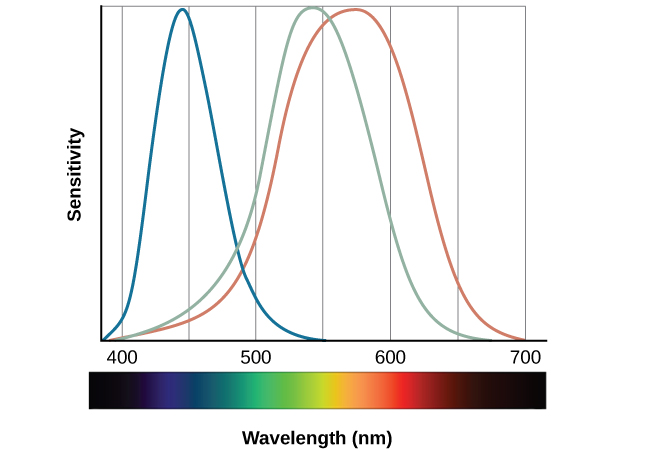Chapter 6: Color Vision
Light is not made of different colors—we perceive color by detecting light of different wavelengths. Short wavelength light is perceived as blue, medium wavelengths as green and long wavelengths as red. By mixing these three primary wavelengths in different combinations we are able to match any color. This is referred to as metameric matching. The trichromatic theory of color vision states that we have three different types of cone, each of which is maximally sensitive to one of the three primary wavelengths. Any wavelength that we can see is coded by the relative activity of the three different cone types, which are commonly referred to as blue (short wavelength), green (medium wavelength), and red (long wavelength) cones (Figure 6.5).

Color Vision Deficiency
As we already mentioned, most people who are “color-blind” can see colors, but they confuse certain ones because they look similar to them. The psychological term for this condition is color vision deficiency. The circles in Figure 6.6 are part of a common test used to see whether people are able to tell red from green.

Despite much recent improvement in gene therapy for color blindness, there is currently no FDA approved treatment for any form of CVD (color vision deficiency) , and otherwise no cure for CVD currently exists. Management of the condition by using lenses to alleviate symptoms or smartphone apps to aid with daily tasks is possible.
Other, much rarer, forms of color vision deficiency include tritanopia and tritanomaly, which affect the blue cones. Figure 6.7 shows how individuals who are missing their red, green, or blue cones perceive red, yellow, green and blue.

Although not especially common, color vision can be affected by diabetes, glaucoma, cataracts, and macula degeneration, as well as by certain drugs and exposure to chemicals. Achromatopsia (a total lack of color vision) can occur because of a congenital lack of cones or may develop after a traumatic brain injury.
